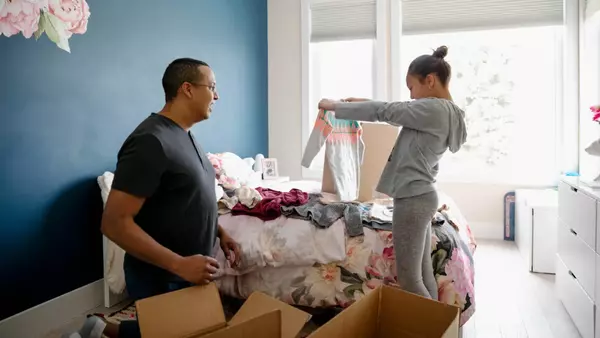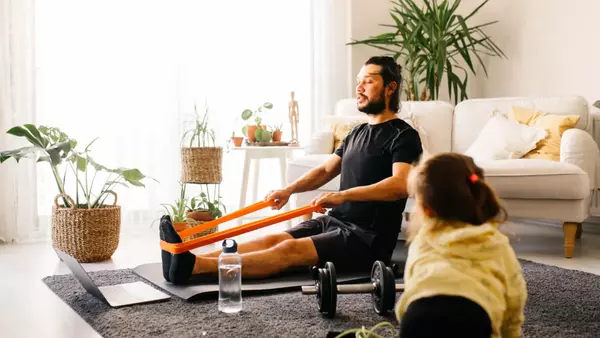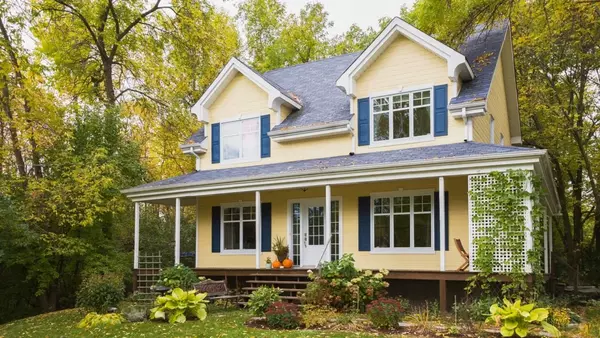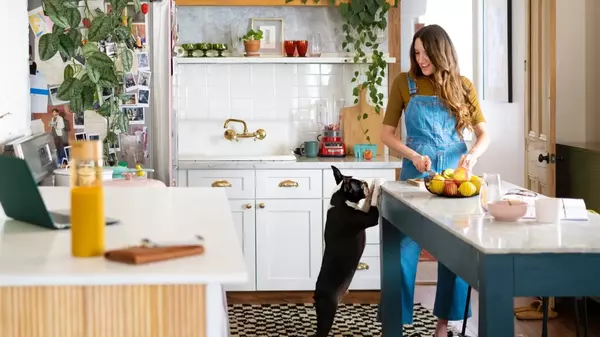10 Tips for Organizing Your Whole House

Getting your home and space organized can help you feel more in control of your environment. That sense of order can reduce stress, help you focus on your own wellbeing and achieve your other goals. Follow these tips to organize your whole home quickly and easily. 1. Set up a no-fail garage system Your garage, if you have one, can be one of the most overcrowded places in the house. Applying an organizing system for your garage can serve as motivation for tackling the rest of your space as it's often the first thing you'll see when you arrive home. Start simple, with just a few materials: Hang some peg board Put some tool hooks in the holes on the board Using a thick marker, draw an outline around each tool to reserve its location. This approach to tool storage can help alert you when tools are missing, and also helps other members of your household put things away because it’s easy to see where to place each item. 2. Cut laundry time in half How can one of the smallest rooms in the house seem so chaotic? And why does doing laundry seem to take up so much time? Here’s a laundry system that will save you time and restore your sanity. First, provide everyone in your household with their own laundry basket. Put their names on the sides of the baskets so there are no lost items or mix-ups. Now here’s the secret: When the wash is done, rather than placing the clean laundry on the dining room table or the stairs (and watching everyone walk by without picking up their clothes), have everyone come to the laundry room to pick up their personalized basket of clean clothing. 3. Work some kitchen magic The kitchen is the activity hub of most homes. It’s a busy area because family members or roommates use the kitchen at least three to five times a day. We open our mail here, study, read, use our laptops and tablets here — not to mention, it’s where the food is. Because we have so many varied activities happening in the kitchen, it’s wise to create separate stations for those activities. One way to accomplish this is to invest in a rolling cart — whatever style and size works best in your kitchen. Use this cart to establish a dedicated space for one of your most common activities. For example, create a lunch-making station stocked with a cutting board and knife, salt and pepper, paper towels, and non-perishable food items (bread, oranges and apples) and snacks. Create the space for your family to assist in making your life easier while also keeping one station of like-items together. 4. Put it in writing Whether you’re a one-person household or a family of five, one tool can save your life or home: a household manual. The beauty of this handy tool is it doesn’t have to be compiled all at one time, and it costs you nothing to create. Grab a three-ring binder and a three-hole punch, and keep your essential information in the binder. To get started, collect your emergency contact info and other vital information such as the name of your vet, school rosters, alarm codes, medication doses for your kids, the name of your father’s caregiver, and where your home’s gas shut-off valve is located. As you continue to organize your home and find more essential documents, you can add to the binder. For those who prefer a digital approach, store your manual on a highly secure cloud service. 5. Use a charging station Many people are frustrated by cell phones, iPad chargers, memory sticks and tangled cords sprinkled throughout the house. Relaxation and recreation activities often seem to need the power of a charging station that’s easily accessible — and it doesn’t hurt if it’s attractive too. One simple solution is to consider a charging station that conceals the cords, keeps all the electronic items together, and looks good while doing it. 6. Tell a tidier toy story Whether it’s grandparents or new parents, one of the biggest complaints of people who share their home with children is about picking up toys. Here’s one idea that will shift your play storage situation from frustration to elation. Use colorful bins to hold toys, designating each bin to hold one type of toy, such as musical instruments, cars, dolls, games or Legos. To make it even easier for children to put items away, find pictures of the toys in magazines or online, and use them to label the bins. If you have dolls or stuffed animals in one bin, attach the matching picture to the front of the bin. Keep the number of bins small, but make sure the bins are large and easy to access. 7. Declutter the bedroom closet Bulging closets and growing piles of clean and dirty laundry may nix the possibility of rest. Decluttering in the bedroom creates a sanctuary for both. Starting with the closet is good move. Once the space is clear, it all boils down to finding what you need when you need it. Here’s a quick process for getting your closet in order: Clear the floor so you can move around easily. Make sure you have proper lighting. Pull everything out. Only put back in what fits you right now, is stain-free, and requires no repairs. 8. Set kids’ closets straight For organizing kids’ clothes, there’s no better tool than a hanging shelving unit. Designate one pocket for each day of the week, and label it. Each weekend, pick out clothes for the following week, and put them in the pockets for the day your child will wear them. Imagine a calm morning without clothing conflict. 9. Bundle toiletries and grooming tools Some bathrooms are small, and everyone seems to have their own favorite shampoo, hairbrush and brand of toothpaste. Drawer, cabinet and counter space tends to run out quickly. If this is your situation, try assigning everyone in the house a bathroom caddy, loaded up with all their cosmetics, toiletries and grooming tools, and labeled with their name. Store the caddies on a shelf in the bathroom or carry them to and from the bedroom. The bathroom stays organized, and there’s an automatic clean-up built in after every visit. 10. Simplify — and go easy on yourself Eliminating clutter is the best thingyou can do to make your home feel more manageable. Less clutter means less stuff to clean and organize in the first place; take just 10 minutes today, and eliminate 10 items you no longer need. Most importantly, don’t get too hung up on the details. Your home doesn’t have to be perfectly organized every day. Sometimes “good enough” is just fine.
Read MoreWhat To Know About Smart Home Tech

Once the exclusive domain of the wealthy and technologically inclined, smart home tools and systems are becoming more accessible and new products are constantly coming on the market. Here’s a brief smart home guide to help get you started with smart devices and connected homes. What's a smart home? Essentially, a smart home uses technology and internet connectivity to automate tasks and make its functions more efficient and convenient. Some examples are thermostats that control the temperature, lights that turn off when you leave a room, or controls that configure your entertainment system for the best movie experience. “While ‘smart home’ is a concept that’s been around for a decade, new technology has made it more common,” says Mark Benson, head of SmartThings, Samsung’s home automation company. In the last few years, smart home devices have become easier to install and use, and they’re becoming more affordable. You can equip your home with a few basic smart home devices for less than $100. Installation can be as simple as downloading an app and screwing in a smart light bulb or outlet adaptor. And as remote work looks here to stay, home offices offer another catalyst for smart home tech adoption. “Consumers are reimagining their homes and thinking about them as places of relaxation, safety and now work,” Benson says. “People want more from their homes, and smart home technology and home automation are helping them make their homes better. That has led to a rapid adoption of smart home tech in just the last few years.” Smart home apps and automation Most smart home devices usually come with a corresponding app or platform, or work with a major smart home ecosystem, like Samsung’s SmartThings, Google Home or Apple’s HomeKit. Third-party manufacturers often offer their own app and indicate compatibility with the larger systems (“Works with Alexa,” for example). If you’re adding to a system, confirm that your additions are compatible with the components you already own. Recently, Alexa, Apple Home, Google Home, and Samsung SmartThings have adopted a common smart home software language called Matter. Matter promises to allow devices to work together across different platforms and ecosystems. If it works as advertised, you could, for example, pair Google Nest controls with Apple HomeKit devices. But Matter or no Matter, it pays to do a little homework before adding to your system. With these devices and apps, you can set up what’s often called ‘home automation,’ like timing lights to turn on and off when you’re on vacation, or shutting down the home for bedtime. “In my house, we have some automation through the SmartThings app that shuts the house down at night,” Benson says. “We call it ‘Good night.’ So, when we’re going to bed, we can just say, ‘Alexa, Good night,’ and the home automation turns off the lights and locks the door.” Types of smart home tech If you’re looking to explore the world of smart home tech, below are a few common starting points. Smart lights and switches Smart lights, including bulbs and switches, are one of the easiest and least expensive entry points to smart home technology. You can control them either remotely, via an app on your smartphone when you’re away from home or with a voice assistant when you are at home. “Installing smart lighting is as easy as putting in a smart light bulb and downloading an app to run it,” Benson says. “You can get a lot of energy savings from turning off lights when no one is in the room,” he says. “You can also set the right mood for watching a movie without going around and hitting every light switch in the room.” You can use smart lights indoors or outdoors, so you can easily control lights on the porch, in the living room or in your bedroom by touching a screen or speaking to a voice assistant. Smart thermostats Smart thermostats, like Nest or Ecobee, are one of the top-selling smart home device types in the U.S. About 30% of North American homes use one, and they now account for half of annual thermostat sales, according to the Department of Energy. Smart thermostats allow you to create programmable temperature settings based on your schedule and needs. They’ll turn off the AC or heat while you’re at work and turn it on an hour before you get home each day, so you aren’t wasting money heating and cooling an empty house. “Smart thermostats use sensors to detect when you’re home, and they only run the HVAC when you are there,” Benson says. “They can save you a lot of money on your energy bill.” Security cameras You can get indoor or outdoor cameras that keep an eye on your house. Outdoor cameras, specifically video doorbells like Ring and Nest, have become extremely popular smart home ideas, Benson says. They can let you answer your door wherever you are, whether it’s the other side of the door or the other side of the country. What’s more, Zillow research shows that listings that mention doorbell cameras can help a home sell about five days faster than those without, so adding one could prove to be a worthwhile investment if you’re thinking about selling in the near future. Video doorbells have sensors that detect motion and turn on the camera when someone steps on your porch. The camera then streams live video to your phone, so you can see who is at the door and even speak to them through your phone. So you can talk to the FedEx guy while you are at work and tell him where to leave your package. And then you can keep an eye out for porch pirates who might steal your package once he leaves it. “Video doorbells add a lot of security and give you peace of mind,” Benson says. Smart locks Smart door locks let you lock and unlock your house with the tap of a finger or voice command — no key needed. You can unlock the house for a guest or the housekeeper while you’re not home. You can set up entry codes that work for only a certain timeframe, so you control who has access to your house. Some smart locks allow you to monitor who comes into your house, in real time, so you can see if your kids got home from school or if the dog walker showed up. Smart home security systems Smart home security setups have come down in price in recent years, with many popular systems costing only a few hundred dollars. These systems usually feature sensors to monitor your windows, and many come equipped with smart locks, doorbell cams, or offer them as add-ons. Some systems also offer smoke and carbon monoxide detectors and professional monitoring. They can either be professionally installed or DIY, hard-wired into your home or battery powered. Smart appliances Even your appliances can now hook up to the internet and do amazing things. You can get smart refrigerators that send a notification to your phone when the use-by dates of your yogurt are near, or send a live video stream of the inside of the fridge while you're at the grocery store, so you can see if you're low on milk or lunchmeat. You can get washing machines and dryers that allow you to run a cycle remotely from your phone, so you can dry a load of clothes for 10 minutes longer without getting off the sofa. These are really next-level smart home devices. Smart home privacy and cybersecurity Unfortunately, smart home devices come with some well-documented privacy concerns. Amazon keeps a copy of everything you say to Alexa, and Google has been keeping the recordings from its voice assistant to train its artificial intelligence. Even your smart light bulbs could be recording data about you that goes back to the bulb’s manufacturer. Remember, you almost always have to enter some personal information to activate a new device, so the manufacturer possesses that data. For now, surrendering some of your data might just be a trade-off for this futuristic technology. Smart home devices also come with some well-documented cybersecurity risks. While it may seem like no big deal if someone gains access to your smart bulb, bad actors can get creative and wreak havoc. At a minimum, take basic security precautions with these systems. Password-protect your wifi, maintain good passwords, keep everything up-to-date, and when possible use two-factor authentication. How to get started with a smart home system It’s easy to scale smart home technology. Buy one or two devices, then expand your smart home one device at a time. “Our statistics show that 74% of people with smart homes started with one device,” Benson says. “They didn’t start with a whole system.” He says Samsung’s research shows most people start with smart lights, then add a smart thermostat, then a smart lock and security cameras. “Lights are extremely accessible,” he says. “As you add more devices to your smartphone over time, your smart home grows with you.” Don’t be intimidated by smart home technology. Dipping a toe into home automation can make your home more comfortable, safer and maybe even more valuable.
Read More8 Value-Adding Home Improvements You Can Do for $1,000 or Less

A farmhouse sink. LED lighting. A pot filler. You might think these relatively low-cost home upgrades wouldn’t add much value, but our research shows that these and other home upgrades with modest price tags could pay for themselves — or even generate big returns — when you sell your home. An analysis of more than 271 features in the listing descriptions of 1.98 million homes sold in 2022 found that some home improvements are associated with higher than expected sales prices.* The features analyzed won’t guarantee that your home will sell for more if you include them in a for-sale listing. But the following upgrades — gleaned from those listings — offers a good starting point for moderately priced home renovation ideas that could add value to your home while making life a little sweeter. Under $500 1. Upgrade your kitchen features If you’re looking for a place to start, you might want to begin with the kitchen. Sellers poured a lot of love into their kitchens, with upgrades that would have been considered unusual before people began spending more time at home cooking during the pandemic. Appliances and features that became popular with home cooks over the past several years topped the list of features associated with a price premium in 2022. Among them: steam ovens, which snagged the number one spot among the improvements. Small steam ovens can be had for under $500, while wall ovens will run you several thousand dollars. The ovens may pay for themselves, however: listings that mentioned a steam oven sold for 5.3% more than expected. Pizza ovens came in second, netting a 3.7% price premium on homes that mentioned one in their listings. Prices vary wildly for the ovens: a commercial grade oven can run you upwards of $10,000, and a residential kit for an outdoor oven can run about $3,000. But you can find some smaller portable units you can incorporate into an outdoor kitchen for several hundred dollars. Homes with farmhouse sinks in which to wash vegetables for all those fabulous pizzas sold for 1.2% more than expected. 2. Add a retreat space When mentioned in a listing description, quiet rooms and personal spaces command a sale price premium of 2.5% for a “she shed.” Keep the cost affordable by creating the space yourself or decorating a shed you already own as a DIY project. 3. Go with LED lighting Switching out older light figures for more energy efficient LED fixtures can save you money on your electric bill and could help you net a higher price when you sell. Homes with listings that mentioned LED lights sold for 1.5% more than expected. Under $1,000 4. Install radiant heat Few things feel as glorious as stepping onto a heated floor after a shower, which may be why homes that include heated floors or radiant heat in their listings sell for a 2.1% premium. Installing radiant heat can be an expensive undertaking, but adding it as part of a bathroom remodel could bring luxurious comfort and eventually pay for itself. Kits consisting of a 120-volt mat that covers a small area of flooring are available to help make this DIY friendly. The mats, which require a thermostat, must be connected to an electric source, so you might consider bringing in an electrician to help with the wiring. According to home care app Thumbtack, the national average cost to install radiant floors with the help of an electrician is $5-$20 per square foot. Installation and operating costs will depend on the type of radiant heat you use, the size of the room, and the cost to demo and install it. For a small to medium-sized bath, you can expect to pay anywhere from $450-$700 for electric floor heating in a small to medium-sized bathroom. 5. Try “luxury” vinyl floors Plank-style vinyl flooring, which can be purchased for as little as $2 square foot, can mimic the look of wood, ceramic tile or stone. It’s become popular with homeowners because of the ease of installing it and the relatively inexpensive cost compared to other types of flooring. Homes that included it in their listings sold for 1.4% more than expected. 6. Incorporate modern farmhouse style While you can create a simple farmhouse look on a small budget, for the last few years, the focus has been on shiplap, a traditional wall covering of interlocking wood panels. Modern shiplap is attractive, and it provides additional insulation against cold weather. Some designers have suggested shiplap may go off-trend in the near future, however. Other elements of this style to consider adding include: Barnboard details Wide plank floors Wrought iron accents Vintage accessories Architectural salvage Reclaimed wood The modern farmhouse look commanded a 2.4% price premium when mentioned in a listing description. 7. DIY Shaker-style cabinets Installing a whole set of new cabinets is a pricey undertaking, but you can still incorporate the popularity of Shaker-style cabinets by replacing only the cabinet doors. You can typically buy individual doors at your local hardware store or cabinet store, or you can custom create them yourself. Home listings that mentioned Shaker cabinets in the listing description fetched a 1.7% price premium. Higher-ticket items Home upgrades that add value don’t have to involve costly, disruptive or time-consuming renovations. But if you’re ready to go even further, these bonus-category home upgrades could also add value to your home. 8. Update your kitchen countertops Buyers are clearly willing to pay more for an upgraded kitchen, and that includes countertops. Quartz and soapstone countertops were each associated with a 2.5% premium, terrazzo brought in 2.65% more and butcher block 1.25% more. Buyers generally also appear willing to pay more when the listing description includes these features: Hurricane shutters, 2.3% more Outdoor kitchen, 2% more Induction stove, 1.7% more Pot filler, 1.6% more Steam shower, 1.5% more New appliances, 1.4% more If you want to make these or other pricier upgrades while you still own your home and you’re short of cash but have at least 10% equity, you might consider home-improvement financing. A second mortgage lets you borrow a lump sum with a fixed interest rate. A home equity line of credit, or HELOC, gives you a credit line with a variable interest rate. If you’re ready to sell and don’t want to make upgrades yourself, a credit at closing toward the cost may help entice buyers who value these home features. If you’re on the fence about whether to make improvements, you might also consider this: Homes with listings that included the words “fixer upper” sold for 4.1% less than expected.
Read MoreHealth and Wellness Upgrades That Make Your Home Better

With self-care becoming more of a priority than ever, many people are focusing on turning their homes into dedicated spaces that help them prioritize their health and wellness. And just like they’ve gotten creative with WFH setups, homeowners have come up with a variety of ways to squeeze in a spot to exercise, meditate and relax at home — whether it’s converting an existing space or adding on a new one. Looking to adopt healthier habits at home as we head into the summer? Here are a few tips to get you started. Add a gym Hitting the gym can be an integral part of your daily routine, and having access to one at home can make heading to the gym — and committing to going often — that much easier. And you don’t have to have a huge space to make the magic happen. If you don’t have the square footage or a hefty renovation budget to allocate towards making an entire room to a home gym, a well-dedicated corner and some strategic equipment (like a single kettlebell, a weighted jump rope or the high-tech and low-profile Mirror) can be perfect for small spaces in an apartment or a condo. Plus, having the equipment in your line of sight daily will motivate you to make working out a more integral part of your daily routine. Rather than throwing your yoga mat in the closet, try to set it out and use it as a friendly reminder to take a few minutes for yourself. Have more room to sweat it out at home? You can opt for bulkier equipment like the tried-and-true treadmill, heavy-duty gym mats, a stationary bike, a rowing machine or weight lifting equipment. Where to store your equipment Deciding where to store your home gym equipment can be a challenge, especially if your home isn’t filled with natural light. Try to find a spot that makes exercising at home relaxing and inspiring rather than a tiring chore that you can’t wait to cross off your list. If you can help it — and you have open space that gets a little sunlight — avoid spaces like windowless rooms or basements that don’t have natural light. Aim to put your setup in a garage, spare bedroom or kids’ playroom if you’re able to fit your equipment in those spaces. This also might open up an opportunity to experiment with additional lighting or floor-to-ceiling mirrors. Add a meditation zone Creating a nice, quiet spot to meditate or reflect is not only a nice asset to have. It’s a full-on necessity for a well-rounded health and wellness routine at home. To create a personal meditation zone, seek out a peaceful space in your home — whether that’s a sunroom, a patio, the corner of your bedroom or even a walk-in closet — and gather or purchase items that help calm you. When you’re making this list, consider a tray of candles, a bundle of soft pillows or an area rug, perhaps. When it comes to the décor, opt for muted or neutral colors for the fabrics, paint and accessories in the room, which will lend to the tranquil vibe you’re trying to create and curate. Use this special space to do yoga, listen to a meditation podcast or simply enjoy some peace and quiet for a few moments. Incorporate soothing colors The colors you choose for your walls may seem inconsequential, but they can really change the entire mood and energy of your home. Paint color can go a long way in helping you create a serene space. Soothing colors like periwinkle blue, sage gray, a soft white or a muted green are perfect for rooms in the home that are intended for calming down and resting, such as a bedroom, bathroom or sunroom. A bonus? Certain paint colors can even help you sell your home for a slightly increased percentage. Create homecation vibes You shouldn’t have to escape your home for a vacation. Although it’s no substitute for an all-inclusive trip to Jamaica or a jaunt around Europe, homeowners are increasingly interested in giving their homes a homecation makeover — incorporating small luxuries to make everyday life feel more relaxing and fun. Adding upgrades such as a heated towel rack or a relaxing rain showerhead are small-scale ways to make your bathroom feel more luxurious. When it comes to your bedroom, consider investing in quality linens or purchasing a large canopy bed. Interested in more permanent vacation vibes at home? Our research shows that including a saltwater pool as a listing feature helped homes sell for about 1.5% more, and in-ground spas, hot tubs and Jacuzzis helped homes sell for 0.7% more, suggesting there is a higher demand for these features. Add smart cleaning technology Smart cleaning technology helps make your home feel like a fresh, healthy and calming environment where you’ll enjoy spending time. Small changes, like making disinfecting a bigger priority at home, will bring you some peace of mind and make your day-to-day lifestyle more calm. Beyond scrubbing and disinfecting surfaces the old-fashioned way, there are multiple high-tech options that you can add to your home, such as touchless appliances — everything from light fixtures to kitchen faucets — and even self-cleaning toilets that clean with every flush (and deep clean with the push of a button).
Read More
Recent Posts











